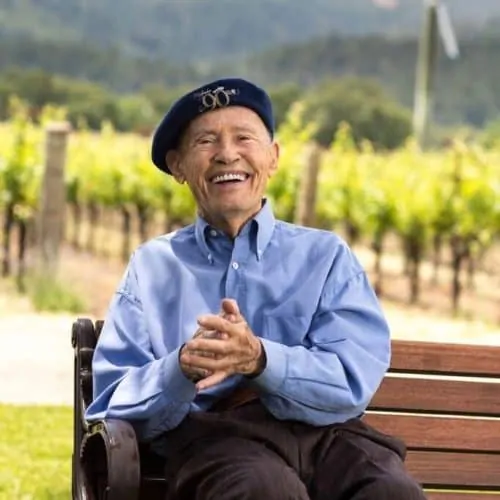By Mort Hochstein
If you follow California wines, you’re familiar with the Judgment of Paris of 1976, the historic, first blind tasting of American wines against the great names of France. Nine judges, all French, gave American wines top honors for Cabernet Sauvignon and Chardonnay, and occasionally mistook French wines for their American competitors. The French were embarrassed. The startling results of that promotional event laboriously assembled by wine merchant Stephen Spurrier (left), put California wines on the map, and served as inspiration for winemakers throughout the world.
The Judgment of Paris gave recognition to a sleeping giant, the American wine industry, and the story was told in 2008, in Hollywood fashion, in the movie “Bottle Shock.” The film focused on Jim Barrett and his slacker son, Bo, at Château Montelena, whose 1973 Chardonnay was the big winner in Paris. While the film paid a lot of attention to the differences between father and son, it gave very little attention to the man who crafted that winning Chardonnay for Montelena, Miljenko “Mike” Grgich, a humble immigrant from Croatia.
Grgich’s life would make a more interesting story. He was the last of 11 children in a family of impoverished peasant farmers in a small village. Wearing hand-me-down clothes and often going hungry, with only a smattering of schooling, Grgich spent his earliest years tending sheep and crushing grapes with his feet for the family’s wine. At age 14, he was running a small grocery store when communists ravaged the village and confiscated his stock. In 1943, scrambling for a route toward a career in a free land, he saw that the communists employed many bookkeepers, and made his move. Grgich attended business school in Zagreb, and worked for a year behind a desk, quitting after he formulated another plan. He signed on for the enology program at the University of Zagreb, looking toward becoming a winemaker in California, his promised land.
In 1954 he applied to study plant genetics in West Germany, which was his way of getting out of Communist Croatia. He crossed the border in fear with five dollars stitched into the soles of his shoes to escape confiscation and possible imprisonment for smuggling cash out of his homeland. He purposely overstayed his visa until the West German government interred him in a refugee camp. The farmer, whose land he had worked as a student, paid for his release and he went back into the fields as a laborer for nearly two years. After two years of frustration, he abandoned his efforts to win a U.S. visa and instead applied for work as a lumberjack in Canada, where it was easier to obtain papers. He worked several years in a variety of menial jobs until a relative, a Canadian priest, advised him to contact the Christian Brothers winery in California. That move linked him with Lee Stewart at the small Souverain winery in Napa who sent him the letter of employment he needed to earn that treasured American visa.
Finally in his promised land, Grgich was on his way, with tattered clothes, little cash, and a bare room in a barren hotel. The Souverain job led him to Robert Mondavi, where all his training enabled him to become a trusted aid to that California icon, who had just built a showcase winery. Mondavi gave Grgich great responsibility and encouragement to polish his winemaking skills, but warned him that the prime positions were reserved for his sons.
Grgich produced the 1969 Mondavi Cabernet Sauvignon, a highly regarded wine that enhanced his reputation and this prompted a financially rewarding offer from Jim Barrett at Château Montelena, a much smaller winery. Mondavi gave Grgich his blessing to move on and promised that he could always return.
Barrett asked Grgich to develop a business plan for a winery to produce world class Cabernet Sauvignon. Grgich advised Barrett that a red wine would produce no income for five years and wrote a program to include white wines that would yield more immediate cash flow. This was the basis for Montelena’s award-winning 1972 Chardonnay and the historic 1973, which cemented the winery’s status.
A winery of his own was now possible and the once penniless immigrant realized his dream, founding Grgich Cellars and picking up accolades as the king of Chardonnay, while creating a battery of classic red and white wines. A bottle of the 1973 Chardonnay was enshrined in the Smithsonian Institution as one of “101 Objects That Made America,” ranking along with such icons as Abraham Lincoln’s hat, Alexander Graham Bell’s telephone and Neil Armstrong’s space suit.
Grgich, at 93, remains active in the winery, which his daughter Violet now directs. Together they published his dramatic memoir, A Glass Full of Miracles.
In New York recently she showed his 40th anniversary Napa Valley Chardonnay ($50) and several other wines. It’s a totally elegant, limited example of his art, crisp with apple and pear flavors and strong, but not overpowering, acidity. The 2013 Chardonnay ($43), which also was on the table, was equally classical, though slightly more mineral in composition, with peach, mango and tropical flavors.
Grgich had been instrumental in formulating Mondavi’s Fumé Blanc, so named when the producer felt Americans might not be comfortable pronouncing Sauvignon Blanc. Rich in aromatics, Grgich Fumé ($31) is high in tropical fruit flavors and lemongrass ones and matches well with everything from fish to cold veggies and roasted beet salad, a dish served at the presentation. On the red side, we enjoyed his 2012 Cabernet Sauvignon ($185) based on vines planted in the late 1950s, among the oldest in Napa. It is a wine of concentrated intense flavor, well balanced, with flavors of blackberries and black licorice and a rich, lingering finish.

